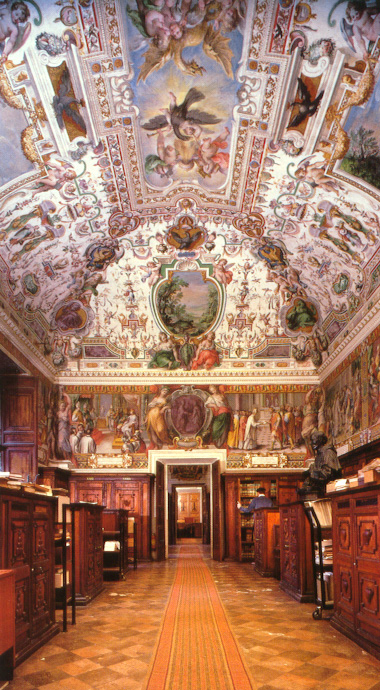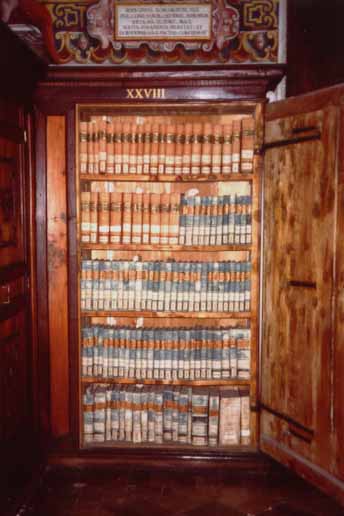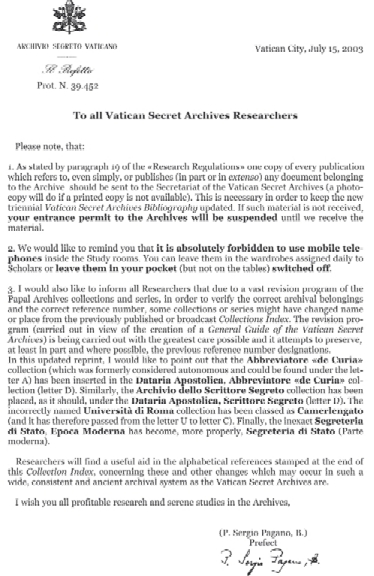|
Rotten Library > Religion > Secret Archives of the Vatican
Secret Archives of the Vatican You would think that the Vatican's Secret Archives would be some dumb conspiracy theory. I mean, it sounds ridiculous. The Vatican's Secret Archives. Let it roll off your tongue. Surely, we're into serious conspiracy weirdness here.
You would think that the Vatican's Secret Archives would be some dumb conspiracy theory. I mean, it sounds ridiculous. The Vatican's Secret Archives. Let it roll off your tongue. Surely, we're into serious conspiracy weirdness here.Except, of course, that there really is such a thing. And it's pretty much exactly what you think it is. There are a lot of reasons for an organization like the Catholic Church to have Secret Archives. After all, they've been in the conspiracy business for millennia longer than Majestic-12. They've been in the disinformation business for about 18 times as long as Donald Rumsfeld has been alive. They were taking secret vows when the Masons were just a bunch of architects. And they have more to hide that Richard M. Nixon on his worst day. The Catholic Church first officially started keeping a library around the fourth century. Formed at the height of the first great heresy craze, the contents of this library included a lot of attacks on heretical branches of Christianity and the documents and scriptures used by these heretical branches (which the Church fathers admitted to having read). The entire contents of the pre-eighth century archives, presumably including all these fascinating heresies, mysteriously disappeared, according to the Vatican's official account of the library's history, "for reasons not entirely known." The library was strictly closed to the public until around the 15th century, when the church decided to open its contents for the masses. OK, not all of the contents. Starting in the fourth century, the Catholic Church, in a position of political power for the first time, had been ruthlessly suppressing what it saw as heresy: "Theodosius is said to be the first (Roman emperor) who pronounced heresy a capital crime; this law was passed in 382 against the Encratites, the Saccophori, the Hydroparastatae, and the Manichaeans. Heretical teachers were forbidden to propagate their doctrines publicly or privately; to hold public disputations; to ordain bishops, presbyters, or any other clergy; to hold religious meetings; to build conventicles or to avail themselves of money bequeathed to them for that purpose. Slaves were allowed to inform against their heretical masters and to purchase their freedom by coming over to the Church. The children of heretical parents were denied their patrimony and inheritance unless they returned to the Catholic Church. The books of heretics were ordered to be burned." Well, most of the books. After all, you would have to be pretty stupid to destroy valuable intelligence on your most hated enemies (read the Catholic Encyclopedia's entry on heresy for a sense of the magnitude of enmity we're talking about here). Around the time the library first opened to the public, Pope Paul IV issued the "index of prohibited books." Reading, possessing or distributing these books had a spiritual penalty of excommunication (i.e., condemnation to hell without appeal), and in Catholic countries, they often had civil penalties as well (of varying severity, depending on the nature of the books). Ironically, the pope issued an order later that same year mitigating the penalties regarding violations of the Index's non-reading list, but the order was conveniently "lost" until 1909. Whoops! Guess they should've invented the Dewey decimal system while they were opening the library. This minor paperwork snafu justified 400 years of suppression and censorship, and when the modification of the order was discovered, it was ignored in favor of 400 years precedent, until the church finally lightened the order (slightly) in 1966.
Starting in the third century, the Church had expressly ordered the destruction of heretical books, but their contents were clearly referenced by the main heresy-hunters of the day, such as Irenaeus, a Father of the Church who wrote extensively about the fallacies of heresy. His texts explicitly admit he had read some of the source materials, as well as showing a great familiarity with the various beliefs of the many different heretic sects in existence at the time. The church's official history of the archives confirms it contained such materials as a resource for those designated to fight against heresy. Thus, the existence of a secret archive became inevitable for an organization obsessed with information control. Whatever form this archive took, it indisputably dates back to the fourth century at the latest. According to the Vatican, the early secret archive contained mainly the names of believers and wealthy patrons of the church, but as noted above, it almost assuredly contained copies of heretical and banned works, information deemed too "dangerous" for the public. As the centuries wore on, the list of banned and dangerous books grew and grew, thanks to repeated expansions of the enemies list and aggressive attempts to snuff out the list's members. The Inquisitions rounded up hundreds of books on topics ranging from Protestantism to Witchcraft and ritual magic, to the libraries of groups like the Knights Templar and the Cathars. The latter groups might have had some particularly explosive additions for the library. Modern Conspiracy theorists have speculated that the Templars and the Cathars could have been protecting secrets like the possibility that Jesus Christ didn't die on the cross as advertised, and that there might be hard evidence to support that claim, not to mention descendents of the allegedly sexless messiah. Pope Pius IV is credited with first officially designating the existence of something which would formally be called the "Secret Archive." The actual building was completed early in the 17th century and remained an ironclad fortress of forbidden information until the end of the 19th century, when it was purportedly opened to select scholars. A heavily edited index of the Archives contents was published, and a large set of rules were developed regarding who got access to what. An even more secret archive known as the "Apostolic Penitentiary" exists, containing papal documents and canon law, and a lot of other stuff which is super-classified. Absolutely no one is allowed access. As the 20th century dawned, the increasingly free flow of information around the world (and the decreasing political power of the Catholic Church) made it more and more difficult for the Vatican to effectively control what people were reading. Archaeological discoveries of ancient Gnostic texts spilled the beans on the original heretics, and a vast surge of interest in all things magical and occult just made things worse. It's difficult to justify banning access to the rituals of witchcraft, just for instance, when every major bookseller in American carries three or four flavors of "Teen Witch Spell Kits."
Among the more recent good guesses were the contents of the Third Secret of Fatima, an allegedly devastating prophecy of doom delivered by the Virgin Mary in a series of appearances to illiterate peasant children which was allegedly revealed by the Church in 2000. Under intense pressure, the Church released a series of 20th century documents from the secret archives relating to papal complicity in the rise of the Nazis in Germany. In addition to Nazi collaboration, the archives are generally thought to contain rather a lot of information about the Catholic Church's wrongdoings, such as the current scandal on priestly pedophilia. In fact, the archives contain miles of allegations concerning the sexual kinks and other vices enjoyed by priests and bishops, dating back to at least the 14th century, and possibly even earlier. Realizing the danger of such disclosures, the Vatican structured access to the archives to allow a minimum of accidental disclosures and a maximum of secrecy. The most obvious way to do this is also the most effective. It's strictly prohibited to go browsing the shelves in the Vatican's secret archives. It's unclear whether even the archive's librarians are allowed to do so. Scholars wishing to review information in the archives have to arrive at the gate knowing exactly what documents they want, which is a pretty crappy way to encourage scholarship but a great way to make sure no one stumbles onto the Explicit Erotic Diaries of Jesus and Mary. Scholars also have to present their research requests in writing in advance, allowing the librarians ample time to decide between their three options in responding — 1) bring out the requested document, 2) claim the document doesn't exist, or 3) admit the document exists but refuse to give the scholar access. So if you were hoping poke around the archives looking for evidence that Jesus was an extraterrestrial, just forget it. You have a better chance of getting a guided tour of Area 51 than getting a glimpse of the Sacred Alien Rectal Probing Device.
|
 While all this sounds pretty revolting to the American mindset, the church officially condones censorship even today: "Censorship of books is a supervision of the press in order to prevent any abuse of it. In this sense, every lawful authority, whose duty it is to protect its subjects from the ravages of a pernicious press, has the right of exercising censorship of books."
While all this sounds pretty revolting to the American mindset, the church officially condones censorship even today: "Censorship of books is a supervision of the press in order to prevent any abuse of it. In this sense, every lawful authority, whose duty it is to protect its subjects from the ravages of a pernicious press, has the right of exercising censorship of books."  Another predictable problem arose when the Vatican admitted the secret archives existed. People very naturally began guessing what might be in there, sometimes very accurately.
Another predictable problem arose when the Vatican admitted the secret archives existed. People very naturally began guessing what might be in there, sometimes very accurately.